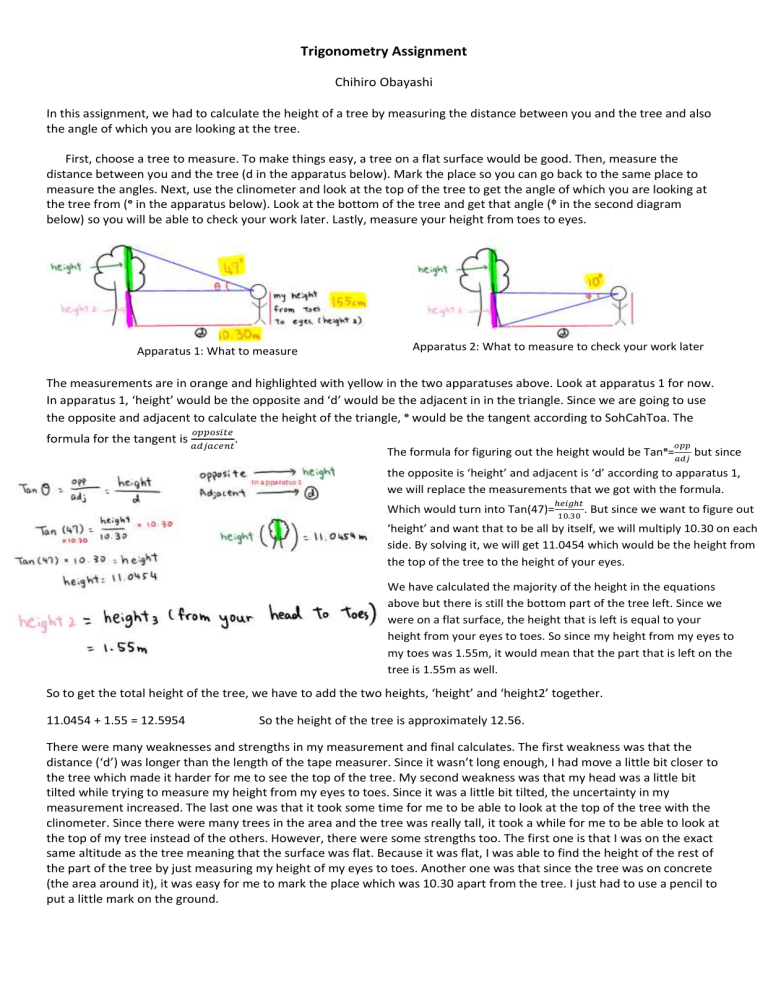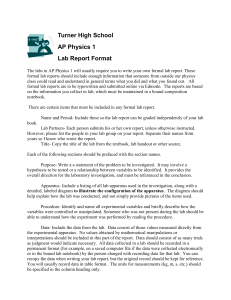Trigonometry Assignment Chihiro Obayashi In this assignment, we

Trigonometry Assignment
Chihiro Obayashi
In this assignment, we had to calculate the height of a tree by measuring the distance between you and the tree and also the angle of which you are looking at the tree.
First, choose a tree to measure. To make things easy, a tree on a flat surface would be good. Then, measure the distance between you and the tree (d in the apparatus below). Mark the place so you can go back to the same place to measure the angles. Next, use the clinometer and look at the top of the tree to get the angle of which you are looking at the tree from (ᶱ in the apparatus below). Look at the bottom of the tree and get that angle (ᶲ in the second diagram below) so you will be able to check your work later. Lastly, measure your height from toes to eyes.
Apparatus 1: What to measure
Apparatus 2: What to measure to check your work later
The measurements are in orange and highlighted with yellow in the two apparatuses above. Look at apparatus 1 for now.
In apparatus 1, ‘height’ would be the opposite and ‘d’ would be the adjacent in in the triangle. Since we are going to use the opposite and adjacent to calculate the height of the triangle, ᶱ would be the tangent according to SohCahToa. The 𝑜𝑝𝑝𝑜𝑠𝑖𝑡𝑒 formula for the tangent is 𝑎𝑑𝑗𝑎𝑐𝑒𝑛𝑡
.
The formula for figuring out the height would be Tanᶱ= 𝑜𝑝𝑝 𝑎𝑑𝑗
but since the opposite is ‘height’ and adjacent is ‘d’ according to apparatus 1, we will replace the measurements that we got with the formula.
Which would turn into Tan(47)= ℎ𝑒𝑖𝑔ℎ𝑡
10.30
. But since we want to figure out
‘height’ and want that to be all by itself, we will multiply 10.30 on each side. By solving it, we will get 11.0454 which would be the height from the top of the tree to the height of your eyes.
We have calculated the majority of the height in the equations above but there is still the bottom part of the tree left. Since we were on a flat surface, the height that is left is equal to your height from your eyes to toes. So since my height from my eyes to my toes was 1.55m, it would mean that the part that is left on the tree is 1.55m as well.
So to get the total height of the tree, we have to add the two heights, ‘height’ and ‘height2’ together.
11.0454 + 1.55 = 12.5954 So the height of the tree is approximately 12.56.
There were many weaknesses and strengths in my measurement and final calculates. The first weakness was that the distance (‘d’) was longer than the length of the tape measurer. Since it wasn’t long enough, I had move a little bit closer to the tree which made it harder for me to see the top of the tree. My second weakness was that my head was a little bit tilted while trying to measure my height from my eyes to toes. Since it was a little bit tilted, the uncertainty in my measurement increased. The last one was that it took some time for me to be able to look at the top of the tree with the clinometer. Since there were many trees in the area and the tree was really tall, it took a while for me to be able to look at the top of my tree instead of the others. However, there were some strengths too. The first one is that I was on the exact same altitude as the tree meaning that the surface was flat. Because it was flat, I was able to find the height of the rest of the part of the tree by just measuring my height of my eyes to toes. Another one was that since the tree was on concrete
(the area around it), it was easy for me to mark the place which was 10.30 apart from the tree. I just had to use a pencil to put a little mark on the ground.
Level
0
1–2
3–4
5–6
Description Indications in the Work
The student does not reach a standard described by any of the descriptors given below.
The student shows basic use of mathematical language and/or forms of mathematical representation. The lines of reasoning are difficult to follow.
The student shows sufficient use of mathematical language and forms of mathematical representation. The lines of reasoning are clear though not always
logical or complete. The student moves between different forms of representation
with some success.
The student shows good use of mathematical language and forms of mathematical representation. The lines of reasoning are concise, logical and
complete. The student moves effectively between different forms of representation.
I recognize and use basic mathematical symbols and terminology.
I attempt to explain my work but it is not always clear.
I have explained the plan and how I have collected the data.
I use appropriate notation and terminology throughout the task.
I clearly explain my work but not always completely.
I have clearly explained the plan and how I have collected the data. I have explained how
I have used the data to calculate the height of the tree.
I use all the appropriate notation and terminology correctly.
I clearly explain my work, with all mathematical information presented logically and concisely.
I have added a conclusion that clearly explains the strengths and weaknesses in my measurement and final calculates.







